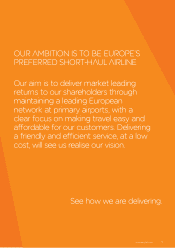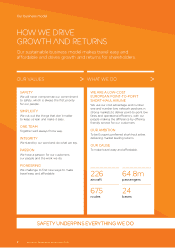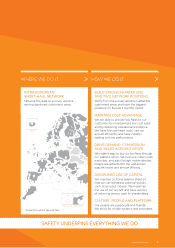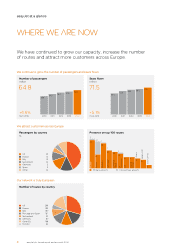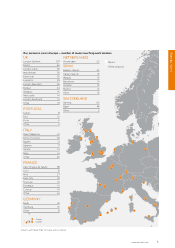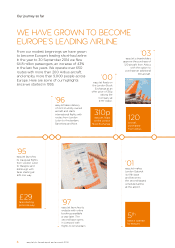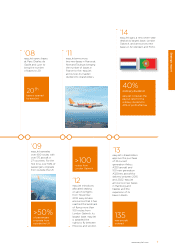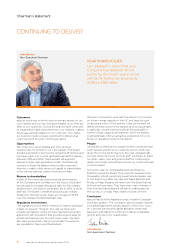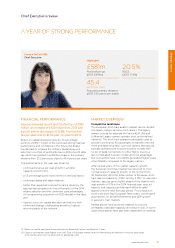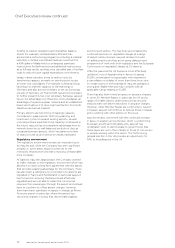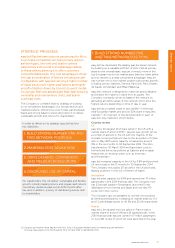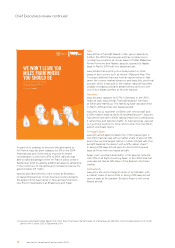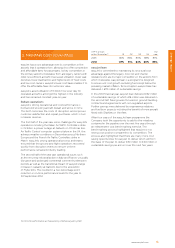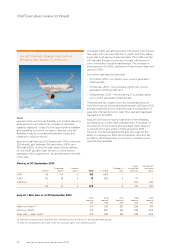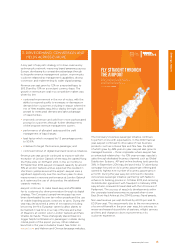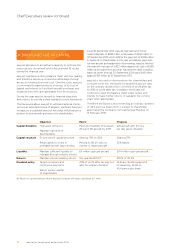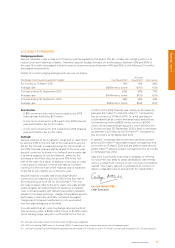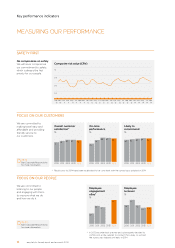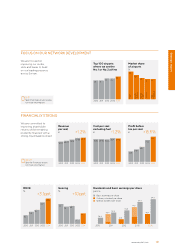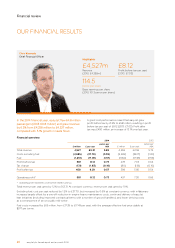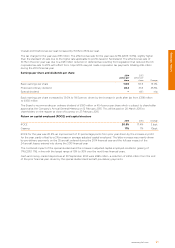EasyJet 2014 Annual Report Download - page 13
Download and view the complete annual report
Please find page 13 of the 2014 EasyJet annual report below. You can navigate through the pages in the report by either clicking on the pages listed below, or by using the keyword search tool below to find specific information within the annual report.
www.easyJet.com 11
Strategic report
STRATEGIC PROGRESS
easyJet flies between airports people want to fly to;
its principal competitors at these primary airports
are the legacy, low-cost and charter carriers.
easyJet has a structural cost advantage relative
to these airlines allowing it to offer customers
more affordable fares. This cost advantage is driven
through a combination of factors including aircraft
configuration with easyJet carrying a higher number
of seats per aircraft; higher load factors and higher
aircraft utilisation driven by its point-to-point model;
its younger fleet and advantaged fleet deal reducing
ownership and maintenance costs, and leaner
overhead costs.
The Company is confident that its strategy of building
on its competitive advantages of a strong network and
market positions, efficient low-cost model, pan-European
brand and strong balance sheet will position it to deliver
sustainable growth and returns for shareholders.
easyJet has developed the leading pan-European network
by building up a valuable portfolio of slots, held at primary
airports over several years. easyJet connects more of the
top European city-to-city market pairs than any other airline
and its network is a clear competitive advantage. easyJet
has number one or two market positions at primary airports
including London Gatwick, Geneva, Paris Orly, Paris Charles
de Gaulle, Amsterdam and Milan Malpensa.
easyJet’s network is designed to maximise asset utilisation
and extract the maximum value from its assets. The
Company constantly strives to balance the network by
allocating aircraft to areas of the network which drive the
highest returns depending on time of day or year.
easyJet has a market share of around 8%(3) in the total
intra-European market and around 32% share in easyJet’s
markets(3). An overview of the developments in each of
easyJet’s key markets is shown below.
Country review
UK
easyJet is the largest short-haul carrier in the UK with a
market share of around 20%(3). easyJet saw growth across
a number of airports in the UK with the majority of the
increase coming at Gatwick due to the acquisition of Flybe
slots in May 2013 where capacity increased by around
15% in the six months to 30 September 2014. The slots
transferred on 30 March 2014 and have been used to
further build the route portfolio at Gatwick and increase
frequencies on existing routes such as Inverness
and Amsterdam.
easyJet increased capacity in the UK by 5.8% and launched
24 new routes in the 12 months to 30 September 2014.
The Company now bases 127 aircraft in the UK and holds
leading positions in nine out of eleven UK bases.
Switzerland
easyJet grew capacity by 6.8% and carried over 10 million
passengers in the 2014 financial year. The Company now
has 23 aircraft based in Switzerland, launched 11 new
destinations from Geneva and Basel and now flies 110
routes from the country.
The Company has consolidated its number one positions
at Geneva and Basel by increasing its market share by 0.4
and 1.2 percentage points to 40.5% and 52.4% respectively.
France
easyJet is the largest low-cost airline in France with a
market share of around 14% and 26 based aircraft. In the
2014 financial year easyJet carried 14.7 million passengers
on over 180 routes of which 24 were launched in the year.
(3) Capacity and market share figures from OAG. Size of European market based on internal easyJet definition.
Historical data based on 12 month period from October 2013 to September 2014.
In order to deliver on its strategy, easyJet has four
key objectives:
For shareholders, this will deliver: sustainable and flexible
growth; industry leading returns and regular cash returns
via ordinary dividends paid out at 40% of profit after
tax; and, in addition, a policy of distributing excess cash
to shareholders.
1. BUILD STRONG NUMBER ONE AND
TWO NETWORK POSITIONS
2. MAINTAIN COST ADVANTAGE
3. DRIVE DEMAND, CONVERSION
AND YIELDS ACROSS EUROPE
4. DISCIPLINED USE OF CAPITAL
1. BUILD STRONG NUMBER ONE
AND TWO NETWORK POSITIONS


